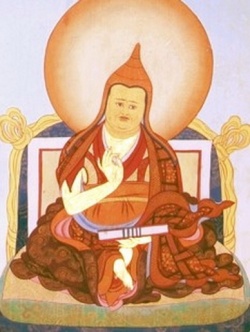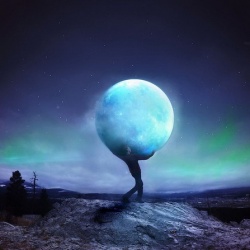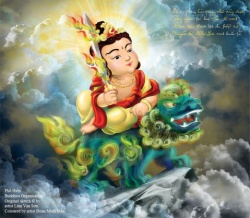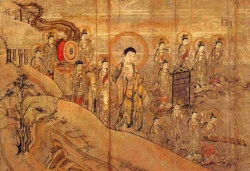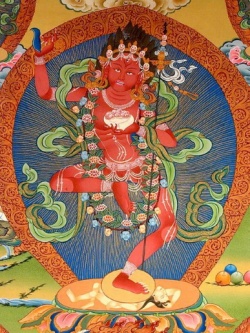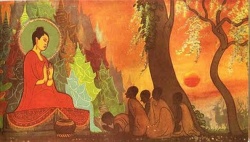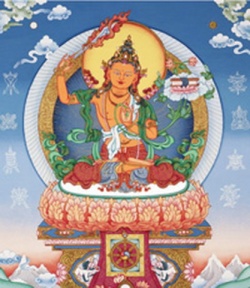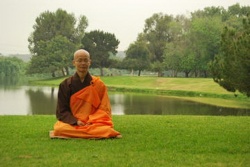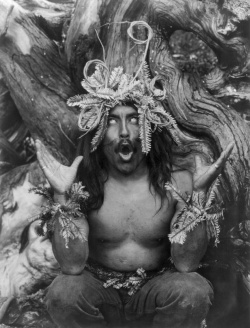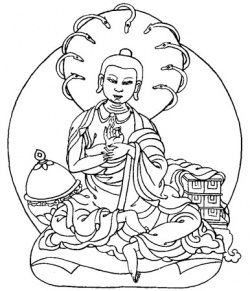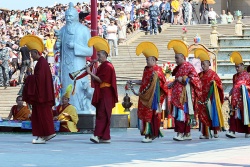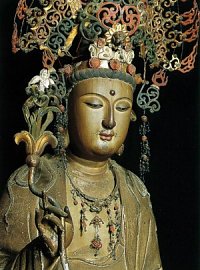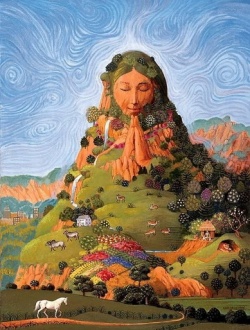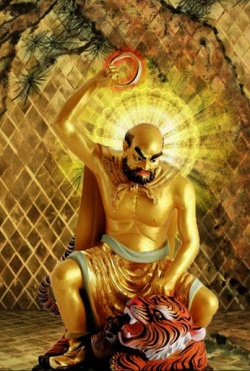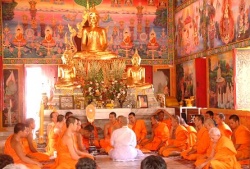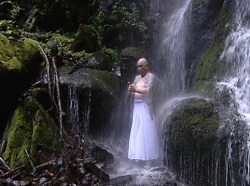Biography of Mipham Jamyang Namgyal
I am an admirer of the great Mipham Rinpoche. Below is his biography. Reading biographies of great masters, we can gather pith instructions from their lives and inspiration to go deeper into our practice. Also, there are many blessings we can receive just by reading about these masters in terms of invoking our sense of renunciation and wishing to follow in their footsteps. It is always recommended especially for those who want to increase their level of devotion and diligence to read the stories of past great masters.
Faith in the past great masters and praying to them for blessings works even if they have passed into parinirvana. For instance, His Holiness Jigme Phuntsok attained full, unshakable realisation of the ultimate nature by reciting Mipham Rinpoche’s supplication prayer and a text written by Mipham Rinpoche on the nature of mind countless times, even though he has never met Mipham Rinpoche. Jigme Lingpa received three visions of Longchen Rabjam, although the latter was already not physically alive, through supplication to him with single-minded strong faith, receiving Longchenpa’s complete wisdom through that. After that the illiterate and unschooled Jigme Lingpa was able to compose unbelievable treatises like Yonten Dzod, a classic on the whole path right up to Dzogchen teachings.
Many people have attested to receiving the blessings of Milarepa through praying to him such that meditative experience blazed up and obstacles in practice were removed. Milarepa had stated that in future anyone who hears his name will not even fall into the lower realms for seven lives. And through his practice, all those in his lineage in future will not have to go through as many difficulties as he did in order to gain great realisation. One can see that all one needs is the faith and sincere one-pointed prayer to the past masters, who have practised and gone through so much difficulties for sentient beings’ sake, to receive so much help on the path, clearing obstacles and even realising the true nature of reality. It is like a treasure in our hands, waiting to be used, if only one can generate the faith to pray.
As it is stated in the “Aspiration Prayer to be Reborn in Sukhavati” by Chakme Rinpoche that with faith, distance of near and far does not matter. So with pure view and faith, praying to the past masters or even present masters whom you have not met, printing out their photos, supplicating it with sincere devotion, and calling upon them by name, I have truly heard of many instances when the wisdom bodies of these masters gave their blessings whether in dreams or actuality and helped the practitioner to overcome all obstacles. Really, with great faith, no time and distance matters because in the dharmadhatu and nature of reality, locality and time does not truly exist. It is possible to receive the blessings across infinite time and space. So have faith and pray.
Supplication Prayer to The Omniscient Mipham Rinpoche
RIG TONG JAM PAL ZHON NU’I JIN LAB LAY GONG PA’I LONG NAY POB PA’I TER GYAD DROL LUNG TOG CHO’I DZOD GYA TSHO’I NGA DAG CHOG AH DZI TA BI DZA YA LA SOL WA DEB
Awareness-emptiness Youthful Manjushri’s blessings
Unties the eight treasuries of eloquence and such within wisdom’s expanse
Supreme lord of the ocean of repositories of dharma teachings and realisation
I pray to you with devotion, Mipham Namgyal
(Note: Mipham Namgyal has the meaning of “being victorious and undefeatable”)
Extracts from the “Brief Biography of The Omniscient Mipham Rinpoche”, written by HH Jigme Phuntsok Rinpoche
I myself have had uncommon confidence and trust in Mipham Rinpoche since I was young… anyone who has diligence, trust and wisdom and who wishes to learn and master the Profound Great Perfection Dzogchen Of Clear Light, the Auspicious Kalachakra Teachings should perform this practice of supplicating (Mipham Rinpoche)
Anyone who supplicates Mipham Rinpoche will temporarily attain the Seven qualities of Gods and Men (ie, noble birth, well-proportioned noble looks, long life, good health, good auspicious karmic connections, great wealth and influence, great wisdom), and have mastery over the peaceful, increasing, magnetizing and wrathful activities. Finally,all those who supplicate him will attain the four kayas and five primordial wisdoms.
The Life of Mipham Jamyang Namgyal (1846–1912)
This biography has been compiled or copied from a number of sources, including Dudjom Rinpoche’s authoritative text, The Nyingma School of Tibetan Buddhism. Some of our sources have come from oral accounts handed down by various Lamas who knew Mipham personally.
——————————————————————————–
Ju Mipham Jamyang Namgyal the Great was born to an aristocratic family in 1846 in Do-Kham, Eastern Tibet. His father was a prince of the Ju family line; his mother came from the Mukpo line. Both of these families were wealthy patrons of Buddhism and sired courtiers in the service of various local feudal rulers established at that time in eastern Tibet and in Mongolia.
Even in young age Mipham Namgyal showed all the signs of an exceptional mind. Already by his seventh year he had memorized a considerable number of scriptural books and poems, including the entire text of the Ascertainment of the Three Vows. He familiarized himself with practical medicine and learnt how to set up astrological charts. At the age of twelve, Mipham Jamyang Namgyal became a novice monk at Sa-nga Chöling monastery in Ju, which was a branch monastery of Sechen, where he proved himself an incredibly gifted student.
At the age of fifteen, he came across an ancient text of the Svarodaya that deeply inspired him. In consequence, he went on a retreat, meditating on Manjushri, the Bodhisattva of Wisdom, for over a year, at the hermitage of Ju-nyung. In conjunction with his meditations, while in retreat, he effected certain alchemical operations for the production of a “pill” (ril-bu’I las-sbyor), with the result that he succeeded in awakening certain of his dormant psychic faculties. After that, it is said that he was able to master any subject of study with the least possible effort. From that point on he demonstrated not only a phenomenal memory, but the exceptional ability to comprehend any book placed before him, merely by flipping through its content at high speed.
When he was seventeen, Mipham Namgyal travelled to Golok, which is in the far northeastern region of Tibet, towards the Chinese border. This move began a life of travel for him.
At the age of eighteen he went on a pilgrimage to central Tibet and visited all the holy places of Padmasambhava. From about this time he acquired renown amongst his peers as a mathematical (sa-ris) prodigy—someone who, when presented with even the most difficult of numerical equations, was capable of giving correct answers almost instantly. Thanks to his maternal uncle’s support, he attended the monastic college of Ganden for a month of intense learning. Following that, he travelled to several devotional places in the region of Lhodrak Karchur, where his spiritual sensitivity was brought to an extreme pitch. At one point, while caught up in an act of devotion, he was so carried away that all ordinary appearances dissolved completely and he found himself absorbed into the supreme vajrapamo-samadhi of bliss and emptiness. This is said to be the moment that initial enlightenment dawned for him. He also came to the intuitive realization of himself as White Manjusri. These facts, however, he kept secret and, out of pure humility, did not reveal during his lifetime, except to a few of his most intimate disciples.
In his travels, Mipham met his two root teachers, Paltrul Rinpoche and Jamyang Khyentse Wangpo. He spent much of this period receiving teachings and empowerments from these and other masters.
On his return to eastern Tibet he further received the transmission and empowerment of White Manjusri according to the tradition of Mati from Jamyang Khyentse Wangpo. Through this ritual the inner experiences acquired during his meditation and devotions in Lhodrak Karchur were crystallized in a concrete manner and the lotus of his heart became permanently open. On this occasion, Jamyang Khyentse Rinpoche made four declarations, proclaiming who Mipham Rinpoche was and prophesizing what would happen. The first was that Mipham Rinpoche’s realization was equal to that of the future Buddha Maitreya. The second was that his knowledge and wisdom was not different from that of Manjushri, who knows everything. The third was that his capability in reason, logic, debate, and philosophy was beyond compare, like that of the great logician and philosopher Dharmakirti. The fourth was that his fame would spread around the world, and that he would become universally recognized. Khyentse Rinpoche then commanded Mipham, who he viewed as his spiritual son, to use his talents to compose textbooks outlining the complete corpus of the Nyingmapa teachings handed down over the ages, and he presented him with a red Pandita hat.
The venerable Khyentse Rinpoche is quoted as having said of Mipham Namgyal: “In the present age there is no one on earth with greater genius than Lama Mipham Namgyal.”
Obedient to his Guru Khyentse Wangpo, Mipham Rinpoche embarked on a period of intensive writing, producing clear and authoritative documentation on the whole range of Nyingmapa wisdom. In particular, he laid out in systematic order the continuity of the Buddhist path, starting with basic Vinaya, and proceeding all the way up to the level of Dzogchen. Nor did his writings explain just the Nyingmapa doctrine alone, but encompassed the whole of Dharma as then known in Tibet, with the result that his encyclopedic output is now studied by each of the four great schools of Tibetan Buddhism.
On one occasion Japa Do-nga, one of the most learned scholars of the Gelugpa order, expressed the opinion that certain of Mipham’s statements in his Commentary on the Wisdom—chapter of Santideva’s Bodhicaryavatara were fundamentally incorrect. This resulted in a number of great and heated debates, the theme of which became the subject of much controversy throughout Tibet. Although the points of controversy still reverberate in those hallowed places where Tibet’s greatest scholars gather to discuss technical matters of Dharma, during present times, it has now generally been conceded, that Mipham’s position was after all the correct one, while Japa Do-nga’s view was mistaken.
Mipham Namgyal himself was not sectarian at all. Although he accomplished the deliberate aim of putting down in written form the specific teachings of his particular school, which he dearly loved and respected, he fully appreciated all the different traditions of Buddhism. He was, in this regard, part of the famous Ri-me, or non-sectarian, movement that developed in nineteenth century Tibet, to which his teacher Jamyang Khyentse Rinpoche and others, such as the great Shakyasri and Patrul Rinpoche, belonged.
Having completed his task of summarizing the whole Nyingma tradition in textbook format, Mipham betook himself to the mountain marked by the sign of Dza, and there in the “Tiger Cave” of Karmo, he practiced meditation. During that time he accomplished the yogas of the Creation-process and through means of the Completion-stage, purified the pulses of all the active energy currents of his maya-body in the direct experience of uncreate Clear Light. Most of all, by means of the technique of Cut-through (thek-chod) and Leap-over into Spontanteous Presence (lhun-grub thod-rgal), as taught in the Nyingma system of Dzogchen, he saw in visionary memory the kaleidoscope of all his previous lives, and fully attained complete absolute Buddhahood, without anything left out.
Mipham Rinpoche traveled extensively. He enjoyed leading the life of a wanderer, teaching his students while traveling from one place to another. He said that this had been very much part of his habit in previous lifetimes, also. The historical Buddha, he pointed out, rarely stayed in one spot for long, but constantly traveled about India.
Mipham became highly respected, especially in Eastern Tibet. Shardza Togden, a very great yogi who many looked upon as an enlightened saint, publicly declared that Mipham Namgyal was the incarnation of the great seventh century Indian yogi Sri Pramodavajra (Tib: Garab Dorje). When Shardza Togden saw Mipham Namgyal and his disciple Khenpo Kunpal together, he said that once more father and son were one, for Khenpo Kunpal, one of Mipham’s spiritual heart sons, was considered Pramodavajra’s intimate disciple, Manjusrimitra. Shardza Togden never hesitated in praising Mipham for his insight and wisdom.
Generally speaking, Mipham Namgyal was never formally recognized or enthroned during his lifetime as an official Tulku or reincarnation of a particular monastery. But near the end of his life he did reveal to some of his close disciples how in meditation he had experienced during the process of Enlightenment the series of his previous lives going backward through time, and therefore knew the history of his stream of consciousness. It is now believed that Mipham Namgyal was an exceptional individual, who in past ages had not only attained Buddhahood as Garab Dorje in northern Pakistan, but later took birth as Nub Sanggye Yeshe 1, to become a young disciple of the renowned Master Padmasambhava in the eighth century. Supposedly he likewise incarnated as Saraha’s (c. 790 AD) teacher Ratnamati and in the eleventh century he was renowned as Atisa Dipankara (982-1054), source of the Kadampa lineage. Still later he incarnated in Tibet a number of times. For example, he was the fairly famous master Dri-me Kunga and the yogi-saint Sangdok Thinley Lhundup. But Tibet was not his only playground; he also underwent lives in more diverse parts of the world, such as India, Iran and Europe. When Mipham was dying, he told his disciples, “for as long as the Universe endures, I shall engage in Bodhisattva activity, incarnating in various pure realms, such as Tushita, and from thence sending emanations of myself into the world, for the sake of all sentient beings.”
Around 1898 or 1899 Mipham Namgyal settled into retreat on Mt. Dza, in the Namgyal Cave of Karmo, where he would remain for the next thirteen years.
Mipham Namgyal possessed an experimental mind, and while in retreat, he also tested out what powers are available in the human being for psychic development. One day his faithful attendant Lama Osel asked his teacher, “What are some of the results of your time in this retreat.” Mipham Namgyal, smiling impishly, then raised his ritual phurba (“magic dagger”), empowered through months of Vajrakilaya practice2, and pointed it at the neighboring, snow covered mountain on the opposite side of the valley. Lama Osel, in his written report, said that at the exact moment of Mipham Namgyal doing this, in response a massive avalanche was let loose on the mountain towards which Mipham was pointing. This has been considered one example of the enormous occult powers mastered by Mipham.
Although Mipham was fascinated throughout his life by the great potential that exists in authentic occultism (sang-ngak), he nevertheless refused to use his own powers in any way that might cause harm to living beings. For this reason he was always meticulous as to how or when, or to whom, he demonstrated such phenomena. He believed that Humanity, still very much in its infancy on this planet, was by no means ready to be taught the secret methods through which psychic faculties may be unleashed. The few works he wrote explaining these faculties and the means to awaken them, he made into treasure texts (ter-ma), sealed with an order of strict secrecy, which he hid in the inter-dimension of Go-kar-mo in the [[Namgyal Cave[[ of Karmo Tagtsang Keutsang, passing his knowledge on only to a select number of his disciples.
On the 1st of March, 1912 in the company of his attendant Lama Osel and his most intimate heart son Khenpo Kunpal, Mipham Namgyal arose from his 13 years of meditation retreat. He admitted to Lama Osel that for the last seventeen years he had suffered from a physical weakness of the heart, which from time to time caused him severe pain and ceaseless ailment of his inner energy channels. This he said was the result of some ancient karma still needing to be worked out. But now, temporarily, the pain was gone. Thus he knew that he had little time to live—only a few months. He therefore opened his doors to all visitors and completed his work by composing certain last testaments for his disciples.
Mipham Namgyal gave his most treasured esoteric lineage-instructions to Khenpo Kunpa l3, who till then had been leading the philosophical courses at the Norbu Lhunpo academy of Kathok monastery. He bade him depart for his homeland in Dza-chu-ka, to the east. He said to Khenpo, at that time,
“Now I shall not remain long in this body. After my death, in a couple of years hence, war and darkness shall cover the earth, which will have its effect even on this isolated snow land of Tibet. In thirty years time, a mad (smyo) storm of hatred will grow like a fierce black thundercloud in the land of China, and in a further decade this evil shall spill over into Tibet itself, so that Lamas, scholars, disciples and yogis will come under terrible persecution. Due to the demon-king Pehar taking power in China, darkness and terror (‘bog) will come to our sacred land, with the result that violent death shall spread like a plague through every village. Then the three lords of materialism (gsum-gyi-kla-klos) and their cousins will seize power in Tibet, spreading war, famine and oppression. No one will be safe. Now, very soon, my mind-stream will be gathered up in the pure-land of Tusita, from whence many emanations [of myself] shall then come forth in future years. I shall not take rebirth in Tibet. In twenty years, seek me in the northern lands of distant Uttarakuru, and elsewhere, east, west, north and south. Fear not, we shall be re-united again, as father and son. Now go!”
Thus Khenpo Kunpal left Kham and established his seat in Dza-chu-ka. He gave up his life of scholarship, and set himself to accomplish his teacher’s instruction by means of strenuous meditation.
Khenpo Kunpal settled at Ge-Gong, the place of his birth in Dza-chu-ka, where he lived until his death in 1945. In the later years of his life he became entirely blind. This, however, did not trouble him deeply, since he spent his time in deep meditation. It is said that he became a great and holy saint. Old and blind, usually dressed in an anonymous simple black tuba, humble like his teacher Patrul Rinpoche, Khenpo would enjoy sitting in the warmth of the sun against the mani-wall of stones that was close to his monastery. Out before him stretched the great vast plateaus of Dza-chu-ka, with far in the distance the red mountains virtually defining edge of Tibet itself. At his death he exhibited wondrous signs of having attained a rainbow body of light and in consequence he left many relics (ring-sels).
After the departure of Khenpo Kunpal, Mipham called together Dodrup Jigme Tenpei Nyima, Sogyal Rinpoche, Dzogchen Tulku, Kathok Situpa, Adzom Drukpa, Shakyasri, Zechen Gyaltsap, and a great number of others, who were all his chief disciples. With tremendous energy he imparted all his main teachings and empowerments to these masters, his beloved heart-sons; in particular, he revealed the highest insights of Dzogchen and Mahamudra. Apparently it was at this time that he publicly announced, “Now, soon I shall depart. I shall not be reborn again in Tibet, therefore do not search for me. I have reason to go to Shambhala in the north.”
Even though it wearied him to deal with quite a number of visitors whose manifestations where distinctly unpleasant to bear, he nevertheless allowed himself to be presented to many large audiences. The stream of visitors continued unabated throughout May and into June of that year, and Mipham, though ailing, worked tirelessly to impart all the blessings he could on the crowds that flocked to see the famous saint.
Evidently he also told his attendant Lama Osel certain prophecies. Although at that time in history the Tibetan people were far more frightened of the British, who in 1904 had once already invaded their country, Mipham told his disciples that their real concern should be with China. He told Lama Osel, “In the future, I am the one destined to be the Rigden King of Shambhala, known as the Wrathful One with Iron Wheel; the one who will conquer the great army of the Mlecchas in the final battle of the world, before the coming of the future saviour Maitreya. This you will see.”4 He also informed Osel that they would be together again, in future lifetimes.
On a Friday, 14 June 1912, in his sixty-seventh year, Mipham Rinpoche sat up in the posture of a Bodhisattva, with his right hand level with his heart in the gesture of teaching and his left hand evenly placed in his lap, and consciously left the body. His body stayed in that position for a considerable length of time afterwards, even though his failing heart had stopped beating and no further breath entered his lungs. Then his body was taken and cremated by Lama Osel, who earnestly strove to perform all the funeral rites in the proper way.
Thus passed away one of the greatest Lamas that Tibet has ever known.
About 100 days after the death of Mipham, Lama Osel was sitting near his master’s stupa, when suddenly Mipham clearly appeared before him. It was as if he was fully physical present. Mipham handed Osel a book or last testament of special instruction and uttered some words. Others later saw this book, although whether it now exists after the Chinese invasion and cultural revolution in Tibet, we do not know. Terton Sogyal and Tubten Chokyi Dorje, both highly respected witnesses, also claimed to briefly see Mipham Namgyal after his death.
Mipham’s works have become the foundation of study not just for the Nyingma lineage, but also for Kagyü practitioners the world over, as well as for others. As predicted, Mipham’s renown has spread throughout the world, and his name is becoming known in the academies and universities of the West. But Mipham Namgyal’s greatest achievement was not his scholarly work. Rather, it was the years he spent as a yogi alone in the wilderness. This is something intangible, which cannot be counted in terms of the books and texts for which he is remembered. The real Mipham, the yogi-saint whose exploits remained hidden from public view, the fully Enlightened One known as Mipham Jamyang Gyamtso Namgyal, is remembered as the beloved father of the mountain ascetics who are free of activity, having, as Dudjom Rinpoche says, “abandoned the cares of this life.” Mangalam.
——————————————————————————–
Footnotes
1. Khenchen Jigme Phuntsok, instead of identifying Mipham as an incarnation of Nub Sanggye Yeshe, states in his biography that Mipham was the incarnation of Chokro Lui Gyaltsen, a young translator who worked under Guru Padmasambhava, very similar to Sanggye Yeshe. We are however, fairly certain that Mipham identified himself as the latter, i.e., as Nub Sanggye Yeshe, rather than the former. In almost every way, Jigme Phuntsok’s account of the life of Mipham agrees with other versions and the oral accounts told to us, except for just a few points here and there.
2. Khenchen Jigme Phuntsok’s account of the life of Mipham says that, instead of raising his phurba (“magic dagger”), Mipham held up the symbolic dice of Vajrabhairava. He also states that it was Sogyal Rinpoche, rather than Lama Osel, who prompted the master at this time. Perhaps the two accounts relate to different events, although the avalanche would appear to refer to a single event?
There are two traditions of practice: one is the practice of Vajrakilaya and the other the practice of Vajrabhairava, which in many ways parallel each other. Both sets of practice confer extra-ordinary psychic powers, as suggested in the story about Mipham letting loose an avalanche. The practitioners of these two traditions have been known, in a certain sense, to compete and vie for power with each other. Presumably Jigme Phuntsok Rinpoche identified Mipham with the Vajrabhairava tradition because of Mipham’s association with Manjusri, with which Vajrabhairava appears as the fierce manifestation. Others, however, state that Mipham developed himself through Vajrakilaya practice, which is, as it were, a wrathful aspect of white Vajrasattva. Both reports may be equally valid; however, Lama Sonam Tobgyal Rinpoche stated on good authority that Mipham Namgyal certainly was an adept in the practice of Vajrakilaya, and that it was a “phurba” which he held in his hand when causing the landslide on Mt. Dza. The latter explanation also appears in tune with other aspects of Mipham’s own writings, not to mention his identification with Sanggye Yeshe and Tsa-sum Lingpa, both great adepts of Vajrakilaya.
3. This was composed in the form of a highly esoteric Kalacakra (“wheel of time”) transmission, that Khenpo Kunpal later imparted to a number of select practitioner’s at Ge-gong Temple in Dza-chu-ka. Mipham revealed that in previous lives he had once been the great Iranian emperor Manju-yasas, and later, the Sage-King of Shambhalah named Vijaya (Tib: namgyal), knowledge-holder of the now largely lost secret cosmical doctrines of the Kalacakra.
4. Khenpo Jigme Phuntsok Rinpoche in his account does not identify Mipham with the future Rigden Warlord, but says instead that he is destined to be a great general named “Senge Bumwa” in that Warlord’s army. Although we have stuck to the account as we have heard it, Jigme Phuntsok Rinpoche’s account may be more authentic, since he had much original source material to refer to. There is a Tibetan prophecy that appears to define the late Dudjom Rinpoche as the coming Rigden King, consequently the matter must be left open to individual insight and understanding. There are also Kalacakra prophecies that centre on the person of the great Panchen Lama of Shigatse. The timescale for the final battle predicted in Shambhalah prophecy is also debatable, Ven. Chogyam Trungpa Rinpoche believing that due to the early deaths of previous Dalai Lamas the time had been shortened. On the basis of Mipham’s life and time of death, some claim that the Great War of the world will occur somewhere around 2030 to 2040 AD; certainly before 2060 AD (i.e., less than 150 years from Mipham’s death). In the Shambhalah prophecy, vivid literary descriptions of this apocalyptical battle appear to portray highly mechanized nuclear warfare, resulting in world-wide destruction on an immense scale. The Buddha referred to this as the Age of the Sword, when men would hide in caves deep in the earth to survive.
Ju Mipam Gyatso (‘ju mi pham rgya mtsho) was born in 1846 in the Derge (sde dge) region. His father, Gonpo Dargye (mgon po dar rgyas), was a descendent of the Ju clan (‘ju) clan, which is said to have a divine ancestry. Ju gets its name from “holding” (ju), which is interpreted to mean “holding on to the rope of the luminous deities who descend from the sky.” His mother, named Singchung (sring chung), was also of high status; she was a daughter of a minister in the kingdom of Dege, where Mipam was born.
His studies began when he was about six years old and he memorized Ngari Paṇchen Pema Wangyel‘s (mnga’ ris pan chen pad+ma dbang rgyal, 1487-1542) Ascertaining the Three Vows (sdom gsum rnam nges), an important Nyingma text outlining the Buddhist path. When he was only ten, Mipam was said to be “unobstructed in reading and writing,” and began to compose a few short texts. Some traditional Tibetan scholars claim that among his earliest compositions, at the age of seven no less, was his famed Beacon of Certainty (nges shes sgron me) a masterwork of philosophical poetry. This would be an amazing feat and is a testament to the high regard in which Mipam’s scholarship and intellect is held.
He became a novice monk when he was twelve, following the local tradition of his homeland. He entered the monastery of Jumohor Sangngak Choling (‘ju mo hor gsang sngags chos gling), which is a branch of the Nyingma of Zhechen monastery (zhe chen) and connected with the lineage of Mindroling (smin grol gling). There he came to be known as “the little scholar-monk.” Early in his life, when he was about fifteen or sixteen, he did a retreat on Mañjuśrī in a hermitage at Junyung (‘ju nyung) for a year and a half. Mipam had a lifelong special connection with Mañjuśrī; it was said that through successfully accomplishing this practice in his youth, he knew the Buddhist scriptures, as well as the arts, without studying. Many of his compositions begin with an invocation to Mañjuśrī, and meditations on various forms of Mañjuśrī, including Yamāntaka, who embodies wisdom’s vigorous activity, were a central part of Mipam’s meditation practice for his entire life.
When Mipam was about seventeen, his homeland of Dege was thrown into turmoil, invaded by the forces of [[Nyakye Amgon Gonpo Namgyel[[ (nyag skyed a mgon mgon po rnam rgyal, 1799-1865), who was then conquering most of Kham. During the fighting, Mipam went to Golok around 1859, accompanied by his uncle. From there he went on a pilgrimage to Lhasa in 1861.
On the trip he stayed at a Geluk monastery of Ganden (dga’ ldan) near Lhasa for about a month. Although his stay was not long, his time at this monastery was significant. Here he was exposed to the Geluk tradition of scholarship, which is famous in Tibet for setting the standard of monastic education. He quickly gained fluency in dominant features of the Geluk tradition’s interpretation of Buddhist thought, as well as the procedures of debate. Mipam would later bring formal debate into the Nyingma tradition.
His facility for quickly ascertaining the meaning of a text is legendary. For example, it is said that when he received teachings from Bumsar Geshe Ngawang Jungne (‘bum gsar dge bshes ngag dbang ‘byung gnas, d.u.) on Candrakīrti’s Introduction to the Middle Way, he told his teacher that he need not bother with a detailed commentary. He asked him only for the reading transmission of this scripture. Introduction to the Middle Way is a text on the profound view of the Madhyamaka, and like most other Sanskrit verses composed in India more than a thousand years ago, it is exceptionally difficult to understand without commentary. Nevertheless, after hearing the teacher read the text just once, Mipam explained it all from the beginning. The teacher then responded, “Although I have the title of ‘Geshe,’ I don’t have even a fraction of the intellect of this one!” He also received Sakya Paṇḍita Kunga Gyeltsen‘s (sa skya pan di ta kun dga’ rgyal mtshan, 1182-1251) Treasury of Reason from the Sakya scholar, Jamyang Loter Wangpo (‘jam dbyangs blo gter dbang po, 1847-1914) and the “Five Treatises of Maitreya” from Solpon Pema (gsol dpon pad+ma, d.u.).
At the beginning of his studies, Mipam is said to have found the texts of the Sarma, or new translations — such as the scriptures belonging to the Sakya, Kagyu, and Geluk traditions — easy to understand, but that the texts of the old translations — his own Nyingma school — were difficult for him. He later attributed this to the fact that he never doubted the profundity of these texts, but that his own faculties were not ready for proper comprehension. Mipam is commonly credited with a nonsectarian outlook, but it is significant that Mipam is reported to have said that he came to discover all the profound points to be found only within the Nyingma tradition. While Mipam showed respect for the different sects in Tibet, he certainly did not gloss over differences, and one can find a strong sense of sectarian identity — Nyingma — in his works.
In his early career, Mipam studied the Bodhicaryāvatāra with Dza Patrul Orgyen Jigme Chokyi Wangpo (rdza dpal sprul o rgyan ‘jigs med chos kyi dbang po, 1808-1887). The teaching only took five days, but apparently this was enough for Mipam to fully comprehend the words and meaning of this classic. He later composed an important commentary on the ninth chapter — the Wisdom Chapter — of this Indian classic. Patrul was later asked, “Who is more learned, you or Mipam?” To which he replied that they were about even in sutra, but that Mipam was much better in tantra.
Throughout his life, Mipam is said to have read the entire collection of the translated words of the Buddha, in one hundred and eight volumes, seven times. Mipam’s knowledge did not always come without effort. He is reported to have struggled with the Vinaya Sutra, a central text outlining the essentials of Buddhist ethics. Only after he read the entire thirteen volumes of the Vinaya section of the Buddhist canon did he express satisfaction with his understanding.
Mipam studied the wide range of Buddhist scriptures with a number of prominent teachers of his day, such as Dzogchen Khenpo Pema Vajra (mkhan po pad+ma badz+ra, c.1807-1884). He considered the Sakya master Jamyang Khyentse Wangpo (‘jam dbyangs mkhyen brtse dbang po, 1820-1892), to be his main teacher. He received instructions on the fundamentals of the Buddhist path, and what are known as the common arts such as grammar, from the famous scholar-practitioner, Jamgon Kongtrul Yonten Gyatso (‘jam mgon kong sprul yon tan rgya mtsho, 1813-1899). Mipam, along with Kongtrul and Jamyang Khyentse, came to be known as “the three Jamgon of Kham”, jamgon being an epithet for a consummate scholar who embodies wisdom.
Mipam is said to have served Jamyang Khyentse Wangpo in three ways: with material offerings, with service, and with practice. According to Jikme Puntsok (‘jigs med phun tshogs, 1933-2004), an avid follower of Mipam, Mipam gave his teacher all his belongings seven times. This was his material offering. As for service, he humbly served his teacher like an ordinary attendant, serving food and cleaning up. His offering of practice, the supreme offering a student can give a teacher, was also exceptional given that he spent most of his life in meditation retreat.
On one occasion, Jamyang Khyentse Wangpo had Mipam sit on a high throne in front of several volumes of Buddhist scriptures. He presented him with extensive offerings and said, “I entrust these scriptures to you. From now on, uphold these teachings through exposition, debate, and composition. You are to illuminate the Buddha’s teachings in this world for a long time!” His teacher thus empowered him and gave him the name Mipam Jamyang Namgyel Gyatso (mi pham ‘jam dbyangs rnam rgyal rgya mtsho). Later, he is reported to have said that there was no one on earth more learned than Mipam.
Mipam’s scholarship dealt with a wide range of topics — logic, poetics, Madhyamaka, medicine, astrology, and tantra, among several others. Following Jamyang Khyentse Wangpo’s request, Mipam wrote commentaries on classic Buddhist texts based on his own Nyingma tradition. He stated that he was motivated by the feeling that most of the Nyingma followers were merely imitating the scholars of other traditions. He felt that the teachings of his Nyingma tradition were on the verge of becoming “like a painted butter lamp”—an artifact without much power. Further, he worried that that few people even wonder about the philosophy of the Nyingma, much less ask about it. For these reasons, he composed texts in order to elucidate the Nyingma view.
By emphasizing a uniquely Nyingma interpretation to fundamental Buddhist doctrines and Indian classics, Mipam’s works sparked criticism from other schools, particularly from scholars in the Geluk school. On several critical points of interpretation, Mipam markedly diverged from the prevailing interpretation given within the Geluk tradition. In particular, his commentary on the Wisdom Chapter from theBodhicaryāvatāra drew sharp criticism that spawned a polemical exchange with a number of prominent Geluk scholars. Mipam took up correspondence with Pari Lopzang Rapsel (dpa’ ris blo bzang rab gsal, 1840-1910,), one of his most perceptive critics from U-Tsang, and they soon became friends, exchanging gifts along with polemical arguments. The rich exchange between these two exceptional scholars came to be known as “the meeting of the Sarma tiger and Nyingma lion.”
A significant moment in Mipam’s life came when he was in a debate with the Geluk lama Japa Dongak (‘ja pa mdo sngags, d.u.), with Patrul Rinpoche was acting as moderator. Mipam and his opponent debated about the famously difficult Wisdom Chapter of Bodhicaryāvatāra. When the debate between the two appeared to be even, someone asked Patrul Rinpoche who was winning. Since Mipam was his student, he said, “A son is not praised by his father, but by his enemy; a daughter is not praised by her mother, but by the community!” He then suggested that they turn to a topic concerning Dzogchen, the highest Nyingma view and practice, upon which Mipam’s opponent had written a commentary. It is during the section on this topic that Mipam won the debate, as declared by the moderator, observers, and acknowledged by the participants.
It is significant that Mipam won the debate on Dzogchen, as it testifies to his skill in engaging the Dzogchen view within a rational, dialectical exchange. Mipam was adamant that Dzogchen is not naive anti-intellectualism, as its detractors have claimed, but involves a subtly profound view that, at least in Mipam’s presentation, both incorporates reason and transcends it. Indeed, central to Mipam’s writing is the prominent place of reasoned inquiry as a means to arrive at the view of Dzogchen, and the interplay of reason and the transcendence of reason.
In addition to his extensive activity in composing commentaries, Mipam spent much of his life in retreat. According to colophons of his works, most were composed during breaks from his practice, suggesting that while not writing he was in retreat. He spent thirteen years in meditation retreat in a cave named Rongme Chime Karmo Taktsang (rong me ‘chi med dkar mo stag tshang) near the Jamyang Khyentse Wangpo’s monastery, Dzongsar (rdzong sar), most likely during the 1870s and 1880s. As recorded in his biography, when Mipam came out of a retreat, Jamyang Khyentse Wangpo asked him how his practice had gone. Mipam responded that when he studied, he tried to see if he could reach the completion of analysis, and when he practiced the generation stage of visualizing the deity, he did so with great diligence to see if he could perfect that practice, too. His teacher replied, “This is difficult. Longchenpa said to rest naturally without doing anything. By doing so, I never saw any natural face of mind with a white complexion and rosy cheeks, but if I were to die right now, I would not have the slightest fear. Ha!” He laughed and Mipam took this to be a practical instruction from his teacher.
His main students included the Fifth Zhechen Rabjam, Pema Tekchok Tenpai Gyeltsen (rab ‘byams pad+ma theg mchog bstan pa’i rgyal mtshan, 1869-1909); Katok Situ Chokyi Gyatso (kaH thog si tu chos kyi rgya mtsho, 1880-c.1923); Terton Sogyel Lerab Lingpa (gter ston bsod rgyal las rab gling pa, 1856-1926); the Third Dodrubchen, Jigme Tenpai Nyima (rdo grub chen 03 ‘jigs med bstan pa’i nyi ma, 1865-1926); the Fifth Dzogchen Drubwang, Tubten Chokyi Dorje (rdzogs chen grub dbang 05 thub bstan chos kyi rdo rje, 187201935); the First Adzom Drukpa, Drodul Pawo Dorje (a ‘dzom ‘brug pa ‘gro ‘dul dpa’ bo rdo rje, 1842-1924) and many others. He is also said to have met and blessed Dilgo Khyentse Tashi Peljor (dil mgo mkhyen brtse bkra shis dpal ‘byor, 1910-1991) as a young boy.
Among prominent Tibetan Buddhist leaders, Mipam is a unique figure in that he was not regarded as an incarnate lama, or tulku (sprul sku), at least not while he was alive. Also, unlike many other important figures of his day, he did not actively promote the new traditions of treasure (gter ma). While the revelations of such texts gained widespread popularity in Tibet, particularly in the Nyingma tradition, he neither discovered treasure texts publicly nor wrote extensive commentaries on them. Rather, he focused his work on elucidating the teachings that were directly transmitted to Tibet from India. Mipam is also reported to have said that he would not take birth again in impure realms, a fairly uncommon refusal to participate in the Tibetan institution of identifying reincarnations of prominent teachers.
Nevertheless, following his death, a disciple claimed that Mipam admitted that he was, in fact, an emanation of a bodhisattva. And despite his declaration that he would not take rebirth, several children were identified as his reincarnation. Jamyang Sherab Gyeltsen (‘jam dbyangs shes rab rgyal mtshan, b. 1930), a grandnephew of Mipam Gyatso, was recognized as his reincarnation, and was given the title Zhechen Mipam (zhe chen mi pham). A prince of Derge, Tsewang Dudul (tshe dbang bdud ‘dul, 1915/16-42), was also recognized as a reincarnation of Mipam. His reincarnation, identified by a Tengye Rinpoche in 1959, is known as the Third Ju Mipam. He is the father of one of the current claimants to the title of Seventeenth Karmapa, Taye Dorje (mtha’ yas rdo rje, b. 1983). The third child, given the title Khyungpo Mipam (khyung po mi ‘pham), was recognized by Jamyang Khyentse Chokyi Lodro (‘jam dbyangs mkhyen brtse chos kyi blo gros, 1893-1959). In 1995 a son of the Eleventh Zurmang Trungpa, Chokyi Gyatso (zur mang drung pa chos kyi rgya mtsho, 1939-1987), Osel Rangdrol Mukpo, was identified as yet another incarnation of Mipam Gyatso by the Third Penor, Lekshe Chokyi Drayang ([[pad nor legs bshad chos kyi sgr] dbyangs]], 1932-2009).
Mipam Gyatso passed away in 1912 at his hermitage at Ju, to the north of Dzogchen Monastery.
Sources
Bstan ‘dzin lung rtogsnyi ma. 2004. Snga ‘gyur rdzogs chen chos ’byung chen mo. Beijing: Krong go’i bod rigs dpe skrung khang, pp. 425-439. TBRC W27401.
Duckworth, Douglas. 2011. Jamgon Mipam: His Life and Teachings. Boston: Shambhala Publications.
Duckworth, Douglas. 2008. Mipam on Buddha-Nature. Albany: SUNY Press.
Dudjom Rinpoche. 1991. The Nyingma School of Tibetan Buddhism, vol. 1. Translated and edited by Gyurme Dorje and Matthew Kapstein. Boston: Wisdom Publications.
Goodman, Steven D. 1981. “Mi-pham rgya-mtsho: An Account of His Life, the Printing of His Works, and the Structure of His Treatise Entitled mKhas-pa’i tshul la ‘jug-pa’i sgo.” In Wind Horse: Proceedings of the North American Tibetological Society, edited by Ronald M. Davidson, 58-78. Berkeley: Asian Humanities Press.
Grags pa ‘byung gnas and Rgyal ba blo bzang mkhas grub. 1992. Gangs can mkhas grub rim byon mingmdzod. Lanzhou: Kan su’u mi rigs dpe skrun khang, pp. 651-653. TBRC W19801.
Jikmé Phunstok. 2008. Miracle Stories of Mipham Rinpoche. Translated by Ann Helm, Nalanda Translation Committee.
Ku byug. 2004. Bod kyi dbu ma’i lta ba’i ‘chad nyan dar tshul blo gsal mig ‘byed. Beijing: China’s Tibetan Studies Press.
Mi nyag mgon po, et. al. 1996-2000. ‘Ju mi pham ‘jam dbyangs rnam rgyal rgya mtsho’i rnam thar mdor bsdus. In Gangs can mkhas dbang rim byon gyi rnam thar mdor bsdus, vol. 1, pp. 742-744. Beijing: Krung go’i bod rig pa dpe skrun khang. TBRC W25268.
Nor brang o rgyan. 2006. ‘Ju mi pham ‘jam dbyangs rnam rgyal rgya mtsho. In Gsung rtsom / nor brang o rgyan, pp. 744-753. Beijing: Krung go’i bod rig pa dpe skrun khang. TBRC W1GS66291.
Pettit, John. 1999. Mipham’s Beacon of Certainty. Boston: Wisdom Publications, 1999.
Phuntsho, Karma. 2005 Mipham’s Dialectics and the Debates on Emptiness. London: RoutledgeCurzon.
Phuntsho, Karma. 2007. “’Ju Mi pham rNam rgyal rGya mtsho – His Position in the Tibetan Religious Hierarchy and a Synoptic Survey of His Contributions,” in The Pandita and the Siddha: Studies in Honour of E. Gene Smith. Edited by Ramon N. Prats. Dharamshala: Amnye Machen Institute.
Sa manta bhadra dharma kirti. 1987. Gangs ri’i khrod kyi smra ba’i seng ge gcig po ‘jam dgon mi pham rgya mtsho’i rnam thar snying po bsdus pa dang gsung rab kyi dkar chag snga ‘gyur bstan pa’i mdzes rgyan. In Collected Works, vol. 8 (hung), 621-732. Kathmandu: Zhechen Monastery.
Douglas Duckworth
January 2013
Source
Wikipedia:Biography of Mipham Jamyang Namgyal
bodhiactivity.wordpress.com
